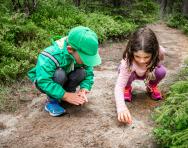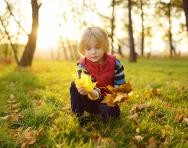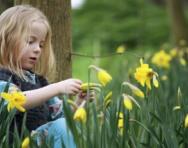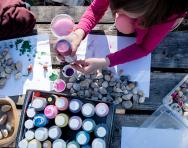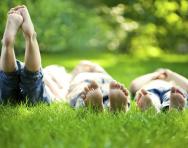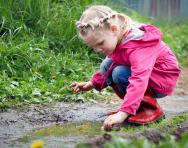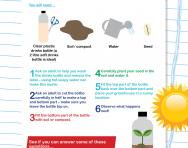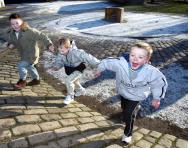What is forest school?
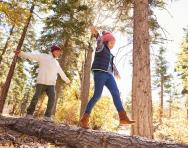
There’s a growing trend in primary schools for getting children into the world outside, come rain or shine, to get hands-on with the natural environment. It’s known as the forest school movement, and while it may seem a new trend in education, it’s steeped in history.
The foundations of forest school were laid in the early 1900s, with the creation of young people’s groups like the Scouts and Woodcraft Folk, which focused on youth camps and outdoor skills. In 1914, London’s first ‘open air nursery’ was launched for children from the slums, and outdoor learning and play has been a fundamental part of early years education in Scandinavia since the 1950s.
In the UK, the forest school movement began to emerge in the UK in the early 1990s, but it’s only in the past decade that it has really gathered force. So what does it involve, and how do children benefit?
Forest school explained
‘Forest school is essentially outdoor, nature-based learning that focuses on the holistic development of the child,’ says Jane Worroll, an ex-countryside ranger and co-author of Play the Forest School Way (£12.99, Watkins). ‘In forest school, activities are provided, but rather than being adult-led, each child chooses and tailors the activity to suit them, while we observe their preferences and development. You flow with the energy of the day and follow what children want to do.’
Lots of schools arrange occasional outdoor activities for pupils, but forest school is a regular, long-term process, rather than a one-off. Typically children will attend forest school sessions six to 12 times a year, ideally throughout the four seasons.


Boost Your Child's Learning Today!
- Start your child on a tailored learning programme
- Get weekly English & maths resources sent direct to your inbox
- Keep your child's learning on track
Despite the name, forest school can take place in any natural outdoor environment, which may be on school premises or in the local area. ‘Forest schools work with the resources they’ve got: the wilder and more natural the better,’ explains Peter Houghton, a trained forest school leader and Jane’s co-author. ‘Ideally it would be held in woodland, but it could be a meadow, a grassy park with a few trees, or even a beach.’
Forest school is child-centred with a high adult to child ratio. Observation, rather than direction, is key, and children learn to care for the natural environment through their activities.
Currently, forest school is more common in rural areas. More private schools than state schools are involved, and it tends to involve the youngest children in schools, in Nursery and Reception classes. ‘However, it has been used with great success for older children with behavioural difficulties, even in secondary schools,’ Peter adds.
The benefits of forest school
Forest school helps children develop many skills that are hard to teach in the classroom. ‘It’s very physical so it encourages children to be active, with lots of activities to develop both fine and gross motor skills,’ Jane says.
Children learn to assess, appreciate and take risks, making sensible, informed decisions about how to tackle the activities and experiences they encounter. ‘They’re learning to be self-sufficient and take care of themselves, which boosts their confidence and self-esteem,’ Peter explains. ‘Through trial and error they learn to deal with failure and develop the resilience to keep trying: a vital skill in the classroom as well as outside.’
Forest school ties in with many areas of the National Curriculum. For example, being outdoors year-round helps children learn about weather and the seasons, which are part of the programme of study in geography, studying mini beasts and plant life relates to the science curriculum, and working on tasks like den building and woodwork links with design and technology.
Children also benefit from the simple act of being outdoors. Research has shown that it improves mental and spiritual health, communication skills and social relationships, among other things. ‘Connecting with nature helps children feel part of the world,’ Jane agrees. ‘Just being outside in nature is calming, and you can see that in how children behave.’
Forest school activities
Because forest school learning is child-directed, the scope of the activities that can take place is enormous. Typical activities include:
- Sensory walks
- Foraging
- Shelter building
- Mini beast hunts
- Tree climbing
- Campfire cooking
- Woodwork
- Nature art
- Games like Hide and Seek
- Fire building and lighting
- Puddle and mud jumping
Keeping children safe
The idea of letting tiny children experiment with knives and fire might sound scary, but safety is paramount during forest school sessions. All leaders have to have a Level 3 Forest School qualification, which covers essential safety training such as risk assessment and food hygiene. Schools can either choose to train an existing member of staff to lead forest school, employ an already trained practitioner, or contract in a forest school service.
Although children are encouraged to assess risk for themselves, this is always with close adult guidance. ‘Before an activity, we’ll sit in a circle and talk about how the children think they can stay safe,’ Jane explains. ‘We do a lot of safety talks before they use any tools, and supervision is tight, with adults observing each child and tailoring the activity to their own ability.’
Staffing levels are high, too: for some activities, children are even supervised one-to-one.
Forest school kit
If your child’s school runs forest school sessions, you’ll be given a list of the equipment you need to provide, and there may be specific items to buy.
Generally, children will need sturdy boots (waterproof walking boots are better than wellies), a hat, waterproof jacket and trousers or an all-in-one suit, waterproof gloves, and layers of clothing – possibly thermals for winter. Long sleeves and trousers should be worn even in summer, to protect them from sun, scratches and insect bites.
Your child’s school will be able to advise you about whether you need to provide sunscreen and insect repellent, and whether they’ll help your child apply it.
Forest school alternatives
Forest school is becoming increasingly popular, but not every school offers it. If your child’s school doesn’t run forest school sessions but you’re keen for them to reap the benefits, there are lots of extra-curricular activities and resources that can help. These include:
- The Scouting movement for boys and girls: Beavers (age 6-8), Cubs (age 8-10½) and Scouts (10½ -14).
- Woodcraft Folk: Woodchips (under sixes), Elfins (age 6-9), Pioneers (10-12) and Venturers (13-15).
- Events and learning ideas from charities like the Woodland Trust, RSPB and the Wildlife and Wetlands Trust.
- Holiday clubs: search online to find out what’s happening in your area, or ask your school or local children’s centre for details of what’s on.
- Camps and courses for families or unaccompanied children: these include Woodland Ways, The Bushcraft Company, WildWise and Bear Grylls’ Survival Academy.
- Forest school lesson plans from the Forestry Commission, which can be downloaded and used at home.
- Books like Play the Forest School Way, Camp Out! The Ultimate Kids’ Guide by Lynn Brunelle, and Get Out! 150 Easy Ways for Kids and Grown Ups to Get into Nature and Build a Greener Future by Judy Molland.
TheSchoolRun also offers a list of 11 easy forest school activities to try at home.

Give your child a headstart
- FREE articles & expert information
- FREE resources & activities
- FREE homework help
